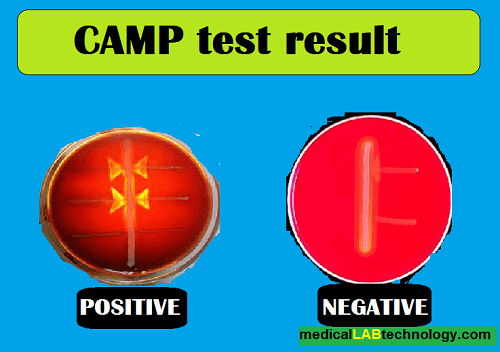CAMP test stands for Christie, Atkins, Munch-Peterson test in microbiology. A clear area around the blood agar plate is a sign of a positive CAMP test.
CAMP test principle
A positive CAMP test produces a clear area around the colony on the surface of a blood agar plate that has been affected by the staphylococcus hemolysin.
Group B streptococci synthesize a protein-like compound called “CAMP- factor” that can act synergistically with the toxin produced by some strains of Staph Aureus to create even more potent hemolysis.
Similar synergistic effects also occur with Corynebacterium Ovis and Rhodococcus Equi. However, an enzyme phospholipase D, secreted by a certain Corynebacterium e.g. C. Ulcerans can prevent the synergistic action of hemolysis of S.Agalactiae in the CAMP test. This can be detected by the inhibition of the CAMP test.
CAMP test procedure
Following are the steps in the procedure.
- Inoculate a streak of betta-hemolysin producing staph aureus (NCTC-7428) down the center of the sheep blood agar plate.
- Inoculate straight lines of the isolates to be tested at a right angle to the staphylococcus line, stopping just before the staph line.
- Incubate the plate overnight at 37 C in the air.
- OR Incubate the plate for 6 hours at 37 C in the 5% to 10% carbon dioxide (Co2).
- Now observe for an arrowhead-shaped zone of hemolysis at the juncture between positive streptococci and staphylococci.
CAMP test reagent and media preparation
- Wash sheep erythrocytes with physiological saline to remove any antibodies to a CAMP-FACTOR.
- After washing resuspend the cells in saline to the original volume.
- Now prepare the camp plate by covering a layer of the nutrient base with a similar layer containing 10% washed sheep erythrocytes blood cells.
CAMP test result
CAMP test-positive bacteria: Group B streptococci, listeria, streptococcus agalactia, ATCC 27956, or NCTC 8181
CAMP test-negative bacteria: E. faecalis, NCTC8213
